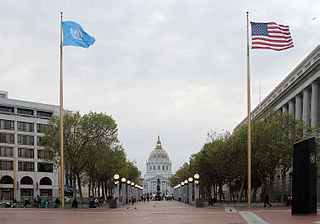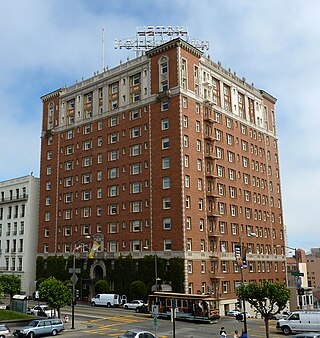
The Presidio of San Francisco is a park and former U.S. Army post on the northern tip of the San Francisco Peninsula in San Francisco, California, and is part of the Golden Gate National Recreation Area.

Alcatraz Island is a small island 1.25 miles (2.01 km) offshore from San Francisco, California, United States. The island was developed in the mid-19th century with facilities for a lighthouse, a military fortification, and a military prison. In 1934, the island was converted into a federal prison, Alcatraz Federal Penitentiary. The strong currents around the island and cold water temperatures made escape nearly impossible, and the prison became one of the most notorious in American history. The prison closed in 1963, and the island is now a major tourist attraction.

Yerba Buena Island sits in San Francisco Bay within the borders of the City and County of San Francisco. The Yerba Buena Tunnel runs through its center and connects the western and eastern spans of the San Francisco–Oakland Bay Bridge, linking the city with Oakland, California. Treasure Island is connected by a causeway to Yerba Buena Island. According to the United States Census Bureau, Yerba Buena Island and Treasure Island together have a land area of 0.901 square miles (2.33 km2) with a total population of 2,500 as of the 2010 census.

Treasure Island is an artificial island in the San Francisco Bay and a neighborhood in the City and County of San Francisco. Built in 1936–37 for the 1939 Golden Gate International Exposition, the island was named by Clyde Milner Vandeburg, part of the Fair's public relation team. Its World's Fair site is a California Historical Landmark. Buildings there have been listed on the National Register of Historic Places, and the historical Naval Station Treasure Island, an auxiliary air facility, are designated in the Geographic Names Information System.

Golden Gate Park is an urban park between the Richmond and Sunset districts of San Francisco, United States. It is the largest park in the city, containing 1,017 acres (412 ha), and the third-most visited urban park in the United States, with an estimated 24 million visitors annually.

The Civic Center in San Francisco, California, is an area located a few blocks north of the intersection of Market Street and Van Ness Avenue that contains many of the city's largest government and cultural institutions. It has two large plazas and a number of buildings in classical architectural style. The Bill Graham Civic Auditorium, the United Nations Charter was signed in the Veterans Building's Herbst Theatre in 1945, leading to the creation of the United Nations. It is also where the 1951 Treaty of San Francisco was signed. The San Francisco Civic Center was designated a National Historic Landmark in 1987 and listed in the National Register of Historic Places on October 10, 1978.

The San Francisco Maritime National Historical Park is located in San Francisco, California, United States. The park includes a fleet of historic vessels, a visitor center, a maritime museum, and a library/research facility. Formerly referred to as the San Francisco Maritime Museum, the collections were acquired by the National Park Service in 1978. The San Francisco Maritime National Historical Park was authorized in 1988; the maritime museum is among the park's many cultural resources. The park also incorporates the Aquatic Park Historic District, bounded by Van Ness Avenue, Polk Street, and Hyde Street.

The San Francisco Ferry Building is a terminal for ferries that travel across the San Francisco Bay, a food hall and an office building. It is located on The Embarcadero in San Francisco, California and is served by Golden Gate Ferry and San Francisco Bay Ferry routes.

Fort Mason, in San Francisco, California originated as a coastal defense site during the American Civil War. The nucleus of the property was owned by John C. Frémont and disputes over compensation by the United States continued into 1968. In 1882 the defenses were named for Richard Barnes Mason, a military governor before statehood. Fort Mason became the headquarters for an Army command that included California and the Hawaiian Islands from 1904 to 1907. In 1912 the Army began building a port facility with piers and warehouses to be a home base for ships of the Army Transport Service serving Alaska, Hawaii, the Philippines and other Pacific Army posts and focus of Army supply for the Pacific.

This is intended to be a complete list of the properties and districts on the National Register of Historic Places in San Francisco, California, United States. Latitude and longitude coordinates are provided for many National Register properties and districts; these locations may be seen together in an online map.
The 49-Mile Scenic Drive is a designated scenic road tour highlighting much of San Francisco, California. It was created in 1938 by the San Francisco Down Town Association to showcase the city's major attractions and natural beauty during the 1939 Golden Gate International Exposition.

The Golden Gate International Exposition (GGIE) (1939 and 1940), held at San Francisco's Treasure Island, was a World's Fair celebrating, among other things, the city's two newly built bridges. The San Francisco–Oakland Bay Bridge opened in 1936 and the Golden Gate Bridge in 1937. The exposition opened from February 18, 1939, through October 29, 1939, and from May 25, 1940, through September 29, 1940; it drew 17 million visitors to Treasure Island.

Architectural Resources Group is a firm that was founded in 1980 by Bruce Judd and Steve Farneth in San Francisco, CA. It began by providing professional services in the fields of architecture and urban planning with particular expertise in the area of historic preservation. In 2000, David Wessel, a Principal of ARG, founded a separate conservation-contracting division, ARG Conservation Services which operates under the same roof as ARG. By 2005, the firm had expanded to a full-service architecture firm with 50+ employees. ARG also opened offices in Pasadena serving Southern California, and Portland, Oregon, serving the Pacific Northwest.
Bruce D. Judd, FAIA, is a historic preservation architect based in Seaside, Florida, and San Francisco, California. He is a principal in the Bruce Judd Consulting Group in Seaside and a Consulting Founding Principal at the Architectural Resources Group in San Francisco. His projects have included surveying the historic African American community of Mound Bayou, Mississippi resulting in its being listed in the National Register of Historic Places. He has also consulted on the restoration of the Alamo Mission in San Antonio, Texas. Judd has directed more than 300 planning, rehabilitation, and expansion projects for architecturally significant buildings throughout the west and is a nationally recognized expert in his field. He has led rehabilitation and new construction projects for library, cultural, and performing arts facilities. He has also directed various high-profile projects including: master plan and restoration of the Hotel Del Coronado; repair and restoration of the San Francisco Conservatory of Flowers in Golden Gate Park, which received a National AIA Honor Award; master planning and seismic retrofit of the block-square Beaux-Arts style Pasadena City Hall which received LEED Gold certification; and rehabilitation of the historic Linde Robinson Laboratory for the Center for Global Environmental Ecology at Caltech in Pasadena, the first laboratory in a historic building to receive a LEED Platinum certification. Judd meets The Secretary of the Interior's Historic Preservation Professional Qualifications Standards in Architecture, Historic Architecture, Architectural History, and History.

Weeks and Day was an American architectural firm founded in 1916 by architect Charles Peter Weeks (1870–1928) and engineer William Peyton Day (1886–1966).

George William Kelham (1871–1936) was an American architect, he was most active in the San Francisco Bay Area.
Sierra Nevada was a steel-hulled steam-powered passenger ferry operated on San Francisco Bay. The ferry was built for the Western Pacific Railroad as Edward T. Jeffery in 1913 and subsequently renamed Feather River. The ferry offered connecting service to San Francisco for Western Pacific train passengers arriving in Oakland, California. The ferry was sold to Southern Pacific Transportation Company when Western Pacific began using Southern Pacific's Oakland ferry facilities in May, 1933. Southern Pacific renamed the ferry Sierra Nevada and placed it in commuter service between San Francisco and Alameda, California until that route was discontinued in 1939. The ferry was leased to the Key System for the Golden Gate International Exposition on Treasure Island from 1939 through 1940. In 1942, the ferry was requisitioned by the federal government to carry shipyard workers from San Francisco to Richmond Yard 1 through World War II. The Richmond-San Rafael Ferry Company purchased the ferry in 1947 and rebuilt it to carry automobiles between Richmond and San Rafael until the Richmond–San Rafael Bridge opened on 1 September 1956. The ferry was then towed to San Pedro, Los Angeles where she sank in 1978.

The Palace of Fine and Decorative Arts, also known as Building 3, on Treasure Island in San Francisco Bay, California, was an aircraft hangar constructed in 1938 for Pan American World Airways' trans-Pacific Clipper services, and then modified for the 1939-40 Golden Gate International Exposition. Building 3 was one of a pair of identical hangars built to house Pan American's flying boats at the south end of the island. Building 1 was to be the airline's terminal building, and Buildings 2 and 3 would house the aircraft. For the exposition, these buildings were converted to exhibition halls, surrounded by a complex of temporary structures. At the end of the exposition all structures but Buildings 1, 2 and 3 were to be torn down to make way for the development of the reclaimed land as an airport for San Francisco.

The Administration Building, Treasure Island, on Treasure Island, California, is a Moderne style building designed by William Peyton Day and George William Kelham. It has also been known as Building 1, as Command Naval Base San Francisco Headquarters, and as Naval Station Treasure Island. It was listed on the National Register of Historic Places in 2008.

The San Rafael Improvement Club, at 1800 5th Ave. in San Rafael, California, was built in 1915. It was listed on the National Register of Historic Places in 1984.




















